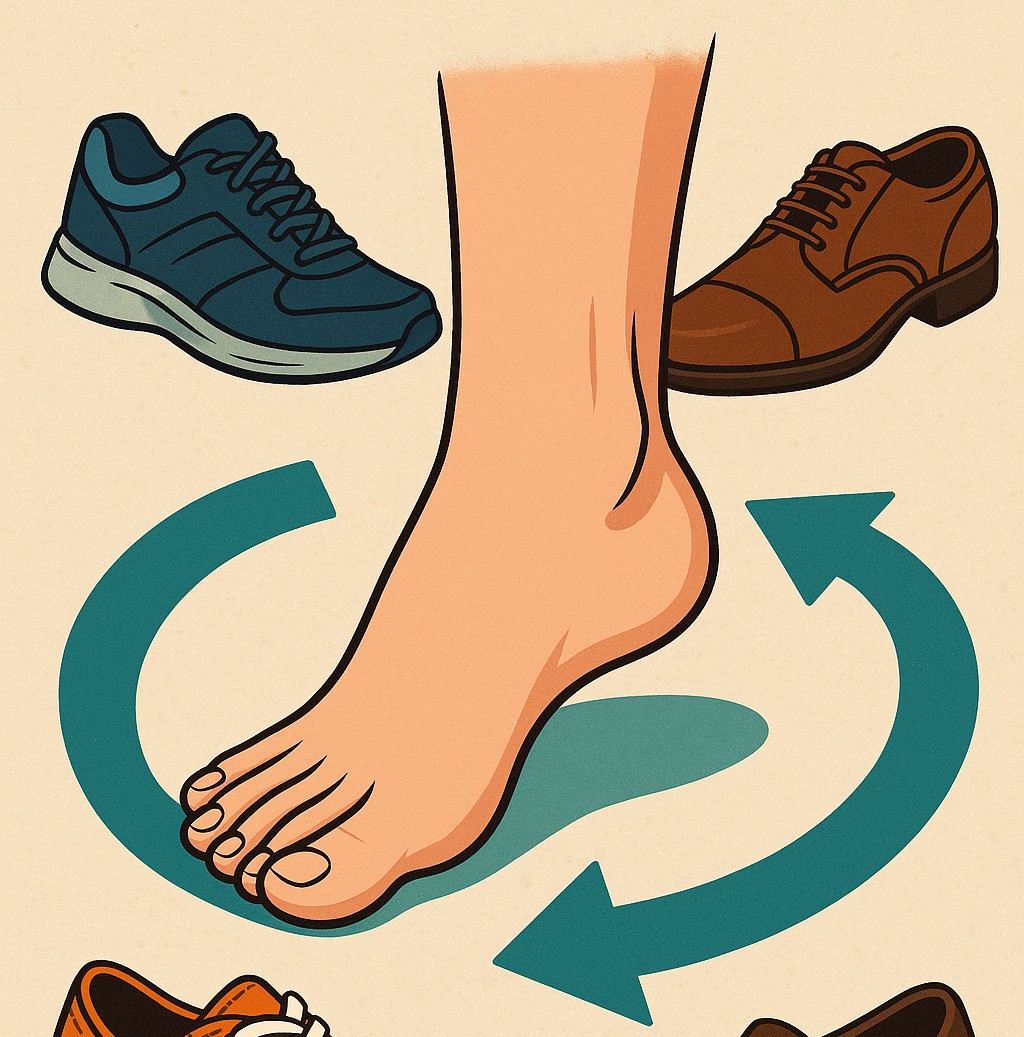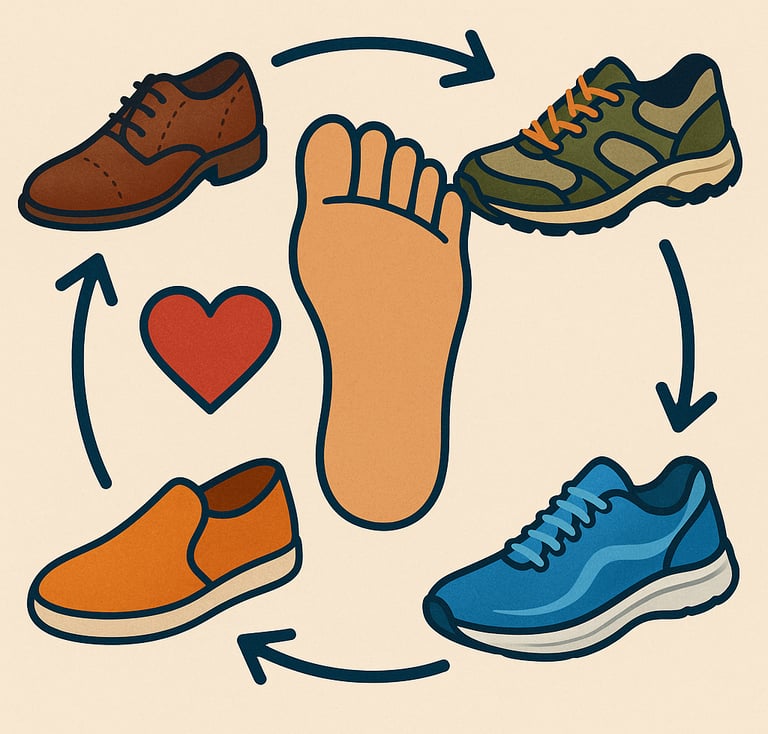Why Shoe Rotation Is Important for Foot Health: A Simple Habit That Saves Your Soles
Discover why shoe rotation is important for foot health. Learn how alternating your shoes can prevent foot pain, extend shoe life, and improve comfort daily.
7/22/2025


Why Shoe Rotation Is Important for Foot Health: A Simple Habit That Saves Your Soles
Meta Description: Why Shoe Rotation Is Important for Foot Health – Discover how rotating your footwear can prevent injuries, extend shoe life, and keep your feet healthy and pain-free.
Understanding Shoe Rotation
What Is Shoe Rotation?
Shoe rotation is the practice of alternating between two or more pairs of shoes rather than wearing the same pair every day. While it might seem like a fashion choice, it actually serves an essential health and maintenance function.
Origins of the Concept in Modern Footwear Care
The idea of rotating shoes isn’t new—it stems from orthopedic advice and was later embraced by athletes, especially runners. Today, podiatrists and sports medicine experts emphasize its importance in preventing overuse injuries and extending footwear longevity.
The Science Behind Shoe Fatigue and Recovery
How Shoes Wear Down Over Time
Shoes endure thousands of steps daily. This consistent pressure wears out the midsole’s cushioning and arch support. Over time, they compress and lose their shock-absorbing abilities, making your feet work harder.
Moisture, Compression, and Structural Stress
Every time you wear shoes, your feet sweat. That moisture gets trapped inside. Without a break, the shoes don’t have time to dry properly, leading to bacterial growth, odors, and structural breakdown.
Health Benefits of Rotating Your Shoes
Reduces Foot Strain and Overuse Injuries
Rotating shoes distributes pressure and impact across different footwear, reducing the chance of developing plantar fasciitis, shin splints, or stress fractures. Your feet also benefit from varied arch support and shock absorption.
Enhances Support for Different Activities
Not all shoes are created equal. Gym shoes, office shoes, and casual sneakers serve different purposes. By rotating accordingly, your feet get the right support for every task.
Extending the Life of Your Footwear
Less Frequent Wear Means Less Frequent Replacement
Wearing a pair less often helps it last longer. Think of it like giving your shoes a day off—they’ll serve you better and longer.
Shoe Drying and Recovery Time
Letting shoes rest for at least 24 hours allows moisture to evaporate fully. This prevents odor buildup and material breakdown, keeping shoes fresh and functional.
How to Create an Effective Shoe Rotation Strategy
Determine Your Weekly Footwear Needs
Start by analyzing your routine: work, workouts, weekend outings. Group shoes by purpose, then assign days based on activities.
Minimum Number of Pairs for Healthy Rotation
Experts recommend at least three pairs:
Daily wear
Exercise or walking
Formal or work shoes
Tips for Rotating Shoes in Different Seasons
In summer, moisture is a bigger issue. In winter, salt and wet conditions affect the outsole. Rotate based on weather conditions to protect each pair from damage.
Common Mistakes to Avoid in Shoe Rotation
Using the Same Pair for All Activities
Doing everything—from gym to grocery store—in one pair leads to quicker deterioration and foot fatigue. Specialized shoes are designed for different loads and movements.
Ignoring Weather and Terrain Factors
Wearing mesh sneakers in the rain? That’s a quick way to ruin them. Choose shoes that match the terrain and climate.
Real User Experiences and Expert Opinions
Testimonials from Podiatrists and Orthopedic Experts
Dr. Angela Peters, a podiatrist, says, “Shoe rotation helps preserve support structures and improves foot health over time.”
Real People Who Benefited from Shoe Rotation
Tom, a teacher, shares: “I used to get heel pain daily. After switching between three pairs, the pain’s almost gone.”
Shoe Rotation for Specific Demographics
Runners and Athletes
Rotating running shoes every 300-500 miles helps reduce impact injuries. Alternate between neutral and stability pairs.
Office Workers and Commuters
Alternate between formal and comfort footwear, especially if you walk a lot or stand frequently.
Seniors and People with Foot Conditions
Those with diabetes or arthritis need extra foot care. Rotating orthopedic or arch-support shoes helps relieve pressure points.
Summary: Healthier Feet One Step at a Time
Rotating your shoes isn’t just smart—it’s a small change that brings huge benefits. Your feet will feel better, your shoes will last longer, and your wallet will thank you.
FAQs about Shoe Rotation and Foot Health
1. How many shoes should I rotate for everyday use?
A minimum of 2–3 pairs is ideal. One for work, one for casual use, and one for workouts or long walks.
2. Can I rotate shoes of different brands or types?
Yes! It’s even beneficial. Different shoes stimulate muscles differently and prevent overuse patterns.
3. Does shoe rotation really prevent foot pain?
Absolutely. It reduces strain, pressure, and gives shoes time to recover—especially the cushioning and arch support.
4. How often should I replace shoes in my rotation?
Replace them when you notice loss of cushioning, visible wear, or every 6–12 months depending on usage.
5. Is shoe rotation necessary if I don’t walk much?
Yes. Even light use causes shoes to compress. Giving them a break keeps them fresh and functional longer.
6. Can rotating shoes help eliminate foot odor?
Definitely. Drying time between wears reduces bacteria growth and keeps shoes smelling clean.
Conclusion: Commit to Comfort and Longevity
Don’t underestimate the power of rotating your shoes. It’s a simple habit that improves foot health, extends shoe life, and enhances daily comfort. Start small—swap shoes every other day—and feel the difference!

